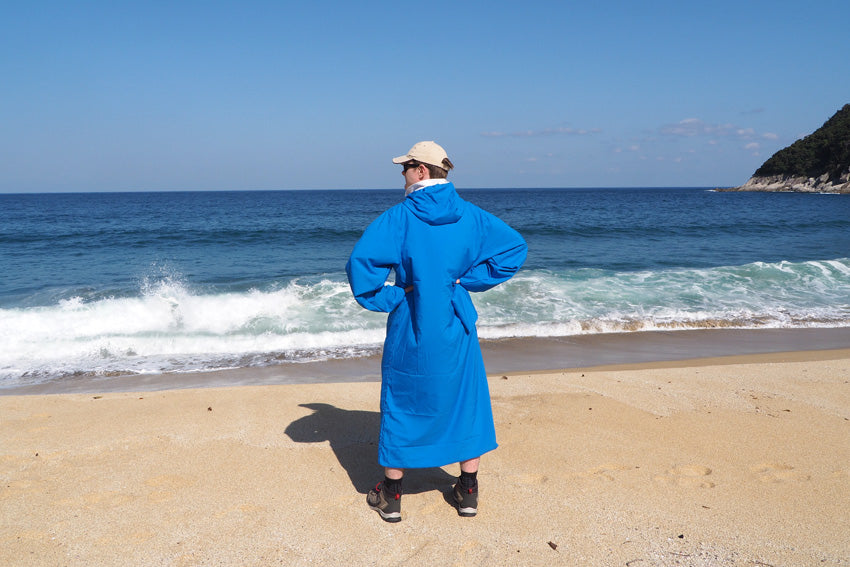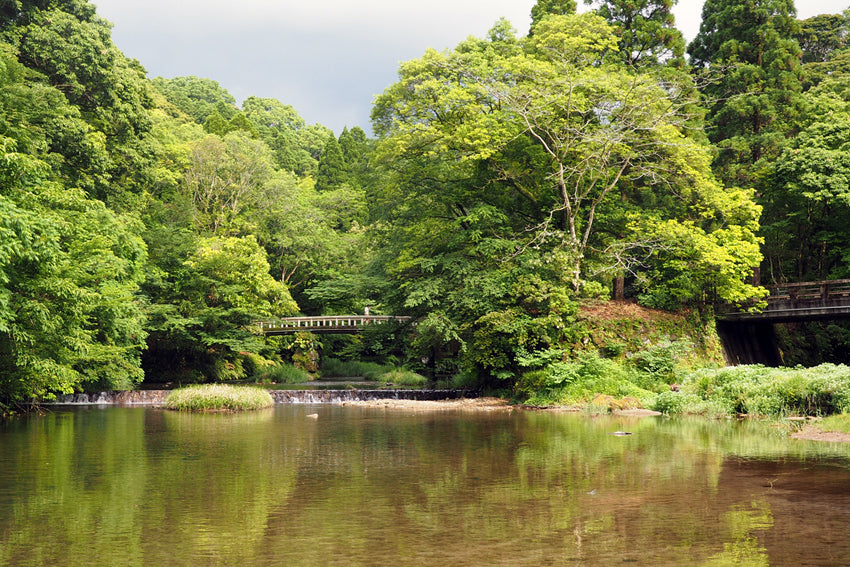CozyBag Goes to Japan’s South

In mid-May, Bergstop's co-owner, Marc Elwert, visited Japan's south at my invitation - Osamu Aridome - the company's newly-appointed Japan representative.
Stunning Landscape
The prefecture or province he visited is called Kagoshima, located in the deep south of Kyushu Island. Kagoshima is comprised of three main regions: Satsuma, Ohsumi, and other islands like world-famous Yakushima. During his 5-day stay, I showed him around mostly in Ohsumi, my home region, which is basically an agrarian region and has not been on a tourist map for international travelers in the past. But as Marc immediately discovered, it is a place of multi-faceted attractions. Not only was he impressed with the beauty of its unspoiled landscape, he also enjoyed Onsen (hot springs), food, water (plenty of natural waters that you can drink from the source), historical and cultural sites, and interaction with the locals.
One of the main attractions of the region is its stunning landscape, which has not been much explored by outsiders. Wherever you go, it is like you owning the whole place for yourself because it is quite rare to see other tourists. We felt that way at Panorama Park Nishiharadai in Kinko Town with the breathtaking view of Kagoshima Bay and Mt. Kaimon (see picture above), and at Hetsuka and Kishira Beach in Kimotsuki Town facing the Pacific Ocean. We had our CozyBag Light and MicroLiner to sleep in the hostels and camping huts, and they proved useful as well to comfortably enjoy the views in the early morning chill.

Sitting on a giant rock at Kishira Beach
On the beach, the MicroLiner protected us from the cold Pacific wind and the strong sun at the same time, being easy to put on and allowing us to move around freely.

Facing the Pacific Ocean at Hetsuka Beach
We also visited Mr. Sakurajima in Kagoshima City, one of the most active volcanoes in Japan and a symbol of Kagoshima. The volcano has been quite active in the past months and we were lucky to have witnessed an eruption, feeling the sheer power of Mother Nature.

Witnessing a volcanic eruption of Mt. Sakurajima
Meeting with Local Culture and Tradition
Another attraction is its historical and cultural sites. Japan is one of the rare societies where religions coexist peacefully. Whereas Shinto, the way of the Gods, is a home-grown indigenous religion, Buddhism came through China and Korea in the 6th century. Depending on the occasion, people follow each religion’s tradition and custom.

We had a chance to visit a Zen temple, Daijiji Temple in Shibushi City, where the head priest happened to be there and guided us around the temple. As it was very cold inside the temple, we could wear the MicroLiner again.

Appreciating the zen garden at Daijiji Temple
We also visited one of the main shrines in the region, Shijukusho Shrine in Kimotsuki Town, where the 900-year old festival called ‘Yabusame” is held annually in October. Yabusame is a horseback archery still practiced as part of festivity in many parts of Japan, but this one is quite special as a total novice, specifically a 14-year old boy, is selected each year and goes through a rigorous training for 45 days before he shows his horse-riding and arrow-shooting skills in front of thousands of spectators. Unfortunately, when we visited the Shrine, there was no training, but we could at least see half of the street unpaved for the horse to run on it.

Feeling history at Shijukusho Shrine
Inspired by Ancient Power
Probably the most striking feature of Ohsimi region is its connection with Japan’s ancient history. There are plenty of ancient burial mounds which belonged to the powerful people who lived there more than a thousand years ago. Among them stands a giant 1300-year old camphor tree which has a heart-shaped hole in the middle. This is one of those places where you get inspired and recharged by Mother Nature’s primordial power.

The 1300-year old giant camphor tree
We also visited Aira Imperial Burial Ground in Aira Town of Kanoya City, which is said to be the burial ground of the parents of Japan’s legendary first emperor, Jimmu. Emperor Jimmu, according to the legend, was born in this region and set sail from the local port to move to Japan’s central region to establish Japan as a nation and to become its first emperor.

Serenity at Aira Imperial Burial Ground
Unlike other major tourist destinations like Tokyo or Kyoto which is crowded with many tourists, this part of Japan offers a very different face of the country with its beautiful and unspoiled nature, healthy and nourishing food, interesting history and culture, and friendly and curious people. It is a place to feel calm, relaxed, serene, and recharged in a quiet pastoral setting.
If you ever plan to visit Japan, don’t miss out its deep south. We can assure you that plenty of pleasant surprises will be waiting for you and it may change your view of Japan. And, needless to say, if you bring our CozyBag products, that would surely make your visit even more comfortable!
*If you are interested in exploring this part of Japan, please contact Osamu. Besides being our Japan representative, he’s been actively promoting tourism of his native region. For more inspiration, see our video here:
Also in News

RollSack - innovative packsack for sleeping bags

Was ist ein Huettenschlafsack?
Klar, ein Hüttenschlafsack ist ein Sack um in Hütten zu schlafen. Aber was zählt als Hüttenschlafsack? Das erklären wir hier in diesem Blogbeitrag.

